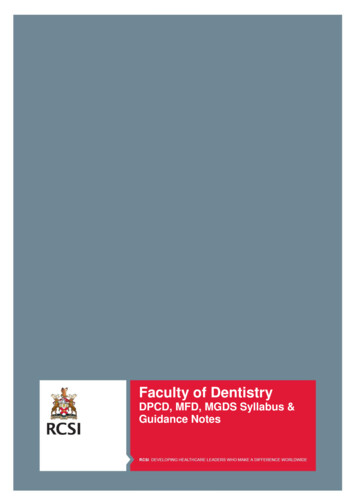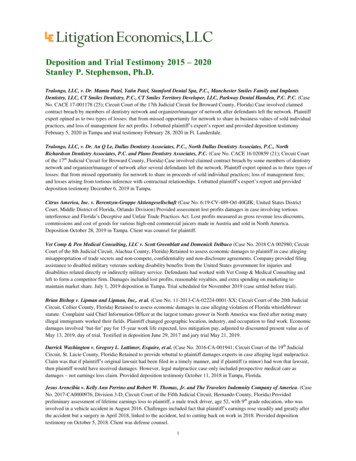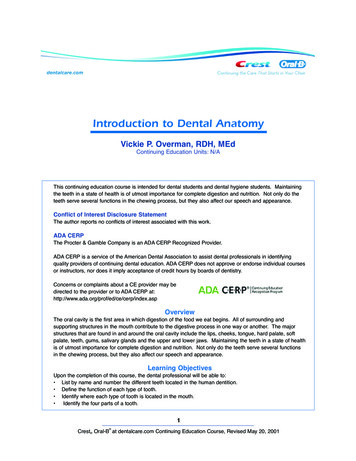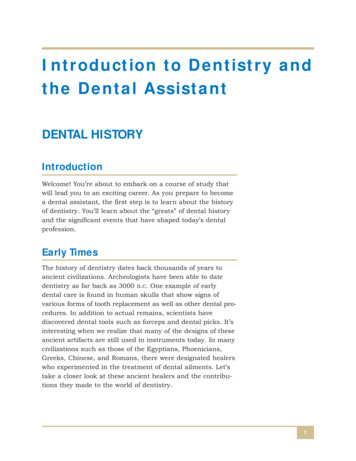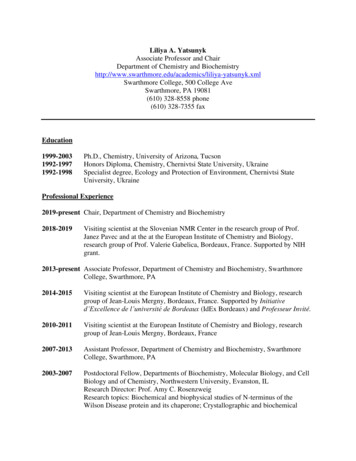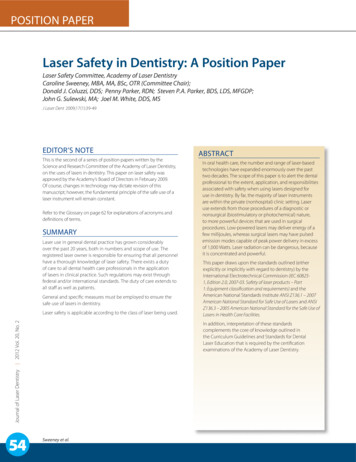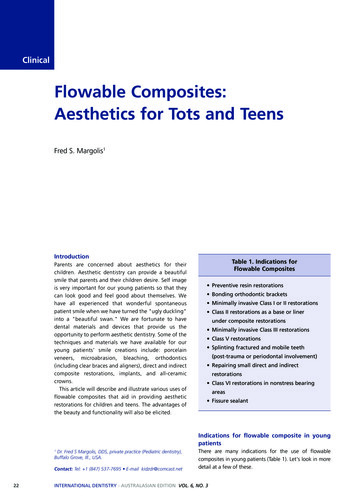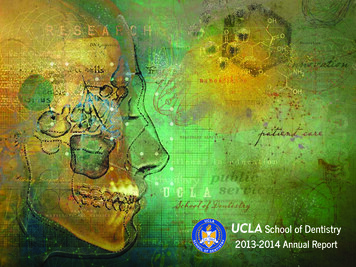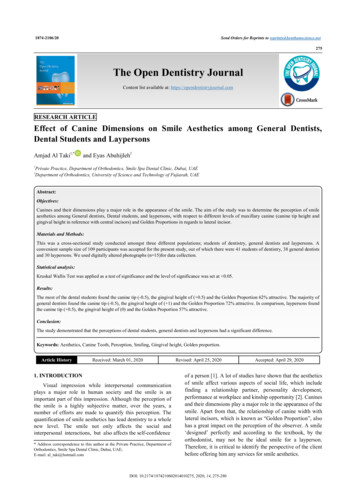
Transcription
1874-2106/20Send Orders for Reprints to reprints@benthamscience.net275The Open Dentistry JournalContent list available at: https://opendentistryjournal.comRESEARCH ARTICLEEffect of Canine Dimensions on Smile Aesthetics among General Dentists,Dental Students and LaypersonsAmjad Al Taki1,*and Eyas Abuhijleh21Private Practice, Department of Orthodontics, Smile Spa Dental Clinic, Dubai, UAEDepartment of Orthodontics, University of Science and Technology of Fujiarah, UAE2Abstract:Objectives:Canines and their dimensions play a major role in the appearance of the smile. The aim of the study was to determine the perception of smileaesthetics among General dentists, Dental students, and laypersons, with respect to different levels of maxillary canine (canine tip height andgingival height in reference with central incisors) and Golden Proportions in regards to lateral incisor.Materials and Methods:This was a cross-sectional study conducted amongst three different populations; students of dentistry, general dentists and laypersons. Aconvenient sample size of 109 participants was accepted for the present study, out of which there were 41 students of dentistry, 38 general dentistsand 30 laypersons. We used digitally altered photographs (n 15)for data collection.Statistical analysis:Kruskal Wallis Test was applied as a test of significance and the level of significance was set at 0.05.Results:The most of the dental students found the canine tip (-0.5), the gingival height of ( 0.5) and the Golden Proportion 62% attractive. The majority ofgeneral dentists found the canine tip (-0.5), the gingival height of ( 1) and the Golden Proportion 72% attractive. In comparison, laypersons foundthe canine tip ( 0.5), the gingival height of (0) and the Golden Proportion 57% attractive.Conclusion:The study demonstrated that the perceptions of dental students, general dentists and laypersons had a significant difference.Keywords: Aesthetics, Canine Tooth, Perception, Smiling, Gingival height, Golden proportion.Article HistoryReceived: March 01, 20201. INTRODUCTIONVisual impression while interpersonal communicationplays a major role in human society and the smile is animportant part of this impression. Although the perception ofthe smile is a highly subjective matter, over the years, anumber of efforts are made to quantify this perception. Thequantification of smile aesthetics has lead dentistry to a wholenew level. The smile not only affects the social andinterpersonal interactions, but also affects the self-confidence* Address correspondence to this author at the Private Practice, Department ofOrthodontics, Smile Spa Dental Clinic, Dubai, UAE;E-mail: al taki@hotmail.comRevised: April 25, 2020Accepted: April 29, 2020of a person [1]. A lot of studies have shown that the aestheticsof smile affect various aspects of social life, which includefinding a relationship partner, personality development,performance at workplace and kinship opportunity [2]. Caninesand their dimensions play a major role in the appearance of thesmile. Apart from that, the relationship of canine width withlateral incisors, which is known as “Golden Proportion”, alsohas a great impact on the perception of the observer. A smile‘designed’ perfectly and according to the textbook, by theorthodontist, may not be the ideal smile for a layperson.Therefore, it is critical to identify the perspective of the clientbefore offering him any services for smile aesthetics.DOI: 10.2174/1874210602014010275, 2020, 14, 275-280
276 The Open Dentistry Journal, 2020, Volume 14With advances in dentistry, it has been possible to ‘design’the smile of an individual. However, in many instances, theperception of an ideal smile varies in people with differentdemographic backgrounds [3]. However, by understanding theperception of a patient, an orthodontist can optimise the shapeof the teeth and height of gingival contours to provide the ‘bestsmile’ [4]. While smiling, central and lateral incisors are mostvisible and, therefore, have the maximum effect on theappearance. However, it has to be remembered that the mesialpart of maxillary canines is also visible and can have animportant effect on the smile aesthetics. The majority of theresearches about smile aesthetics are based on the dimensionsof central and lateral incisors. There exists a relative vacuum interms of research on the role of maxillary canines on smileaesthetics. Changing gingival height can also influence theappearance of the smile, but the gingival margin of canines haslittle influence on it. But again, not many studies are done toevaluate this hypothesis. Therefore, the current study is basedon the effect of dimensions of maxillary canines and gingivalheight on smile aesthetics. The study aims to determine theperception of smile aesthetics among general dentists, dentalstudents, and laypersons, with respect to different levels ofmaxillary canine (canine tip height and gingival height inreference with central incisors) and Golden Proportions inregards to lateral incisor.Al Taki and AbuhijlehUSA). The length and gingival height of canines in relation tocentral incisors and width of canines (to follow the rules ofGolden Proportions) were altered in relation to the lateralincisors. Based on modifications, three sets of photographswere prepared and these digitally altered photographs wereused for data collection Figs. (1-3).Fig. (1). Set one of the smile photographs with various lengths ofcanines. A. Canine tip of the same height as the central incisor edge(0), B. Canine tip longer by 1 mm in relation to the central incisor edge( 1), C. Canine tip shorter by 1 mm in relation to the central incisoredge (-1), D. Canine tip shorter by 0.5mm in relation to the centralincisor edge (-0.5), E. Canine tip longer by 0.5 mm in relation to thecentral incisor edge ( 0.5).2. MATERIALS AND METHODSThe current study was a cross-sectional study conductedamongst three different populations; students of dentistry,general dentists and laypersons. A convenient sample size (inline with other similar studies) of 109 participants wasaccepted for the present study, out of which there were 41students of dentistry, 38 general dentists (with nospecialization) and 30 laypersons (college educated). Writteninformed consent was obtained from all participants.2.1. Data Collection ToolsA photograph of smiling female patient was utilized toknow the perceptions of study groups (students of dentistry,general dentists and laypersons) about the smile aesthetics.Multiple photographs were taken of a smiling female patientwith a Nikon D750 DSLR camera. It is a camera with 24.3megapixel resolution, CMOS image sensor, EXPEED imageprocessor, 10 mm macro lens (Tokina Co.) and Sigma Flashring EM 140-DG. An Sb-r200 twin flash system (Nikon Corp.Japan) was attached using an adjustable scorpion medicalbracket (Agno’s Tech Engineering Co.). To assure the highquality of photograph, the camera was set up with thefollowing options: ISO 100, 100 mm, f/45, and 1/60 s exposuretime. The photograph was taken at the same height as that ofthe subject and from a distance of 0.5 meters.From 10 photographs, one photograph was selected basedon the quality and study criteria by the investigators. It wasensured that the photograph was closest to the naturalappearance, right positioned and taken in a good light. Fromthis photograph, the only portion containing lips, gingiva andteeth was kept and other features of the face were removed.This photograph was modified using Adobe Photoshop CS6photo-editing software (Adobe Systems Inc., San Jose, CA,Fig. (2). Set two of smile photographs with various heights of gingivaof canines. A. Gingival height longer by 1 mm in relation to the centralincisor ( 1), B. Gingival height of the same height as the centralincisor (0), C. Gingival height longer by 0.5 mm in relation to thecentral incisor ( 0.5), D. Gingival height shorter by 1 mm in relation tothe central incisor (-1), E.Gingival height shorter by 0.5 mm in relationto the central incisor (-0.5).Fig. (3). Set three of the smile photographs with various GoldenProportions. A. Golden proportion of 52%, B.Golden proportion of57%, C. Golden proportion of 62%,D. Golden proportion of 67%, E.Golden proportion of 72%.2.2. Method of Data CollectionEach photograph was printed in a 4 inch x 6 inch paperwith matt finish. All of them were provided uniqueidentification numbers and shown to study participants. Thatway, each participant had to evaluate 5 photographs. Initially,the photographs were given in random order to each
Effect of Canine Dimension on Smile Aestheticsparticipant. They were asked to observe each photograph for 10seconds and rate them out of 5 according to their perception.More rating would mean the participant finds the photographaesthetically more attractive. The participants were instructedto organize the images with ascending order of ratings untilthey have achieved a final rank order within the given time anddisregard the code at the back of each picture.2.3. Definitions Used2.3.1. Golden ProportionGolden proportion means the percentage width of canine inrelation to the lateral incisor. For example, a Golden Proportionof 52 means the visible width of canine in the photograph is52%, compared to the visible width of the lateral incisor.2.3.2. Data Entry and AnalysisThe data were entered in MS Excel 2010 and analysed withSPSS v23. The means and Standard Deviations (SD) of ratingswere calculated and compared between different groups toidentify if there was any significant difference between theirperceptions. Kruskal Wallis Test and Mann Whitney U Testwere applied as a test of significance (where ever applicable)and the level of significance was set at 0.05.The Open Dentistry Journal, 2020, Volume 14 277rating for this photograph (mean of 3.53 with SD of 1.33). Thestudents of dentistry and General dentists found smiles with thecanine tip of the same height as the central incisor edge (0) asmost attractive. Compared to that, the laypersons found thecanine tip longer by 0.5 mm in relation to the central incisoredge ( 0.5) as the most attractive.Table 3 demonstrates that there was a significant differencein perceptions of three study populations regarding the gingivalheight [for (-1), (-0.5),0, ( 0.5) and ( 1)]. In case of thephotograph with the gingival height of the same height as thecentral incisor (0), the highest mean score was given by thestudents of dentistry (3.61), while in case of the photographwith the gingival height longer by 1 mm ( 1) in relation to thecentral incisor, the highest mean score was given by generaldentists (3.26). Similarly, for photographs (-1), (-0.5) and( 0.5), the highest scores were given by laypersons (3.27),general dentists (3.26) and laypersons (4.20), respectively. Thestudents of dentistry found the smiles with the gingival heightof the same height as the central incisor (0) as the mostattractive, while general dentists and laypersons found thegingival height longer by 0.5 mm in relation to the centralincisor ( 0.5) as the most attractive.Table 1. Characteristics of the study sample.3. RESULTSTable 1 describes the study groups. The mean age ofstudents was 22.12 years. As expected, the mean age of generaldentists was higher than the students (29.63 years). The meanage of laypersons was 28.9 years. The majority of theparticipants amongst students and laypersons were males(about 53%). About 68.4% of general dentists had workexperience of more than 3 years. The majority (61.0%) of thedentistry students were from the 4th profession.Table 2 shows the rating of perception regarding caninelength in comparison to central incisors. As it is evident, thestatistically significant difference was seen only with thephotograph where the canine tip was longer by 0.5mm inrelation to the central incisor edge. Laypersons gave the highestCharacteristicsDentalStudentsGeneral DentalPractitioners(N 38)LayPersons(N 41)Age (Mean SD) in22.12 1.70completed years(N 30)29.63 3.4428.90 3.0GenderMales22 (53.7%)16 (42.1%)16 (53.3%)Females19 (46.3%)22 (57.9%)14 (46.7%)1-3 years-12 (31.6%)-More than 3 years-26 (68.4%)-4th25 (61.0%)--5th16 (39.0%)--ExperienceLevelsTable 2. Comparison of perception scores about the canine tip in different study groups.CharacteristicsDental Students General Dental Practitioners Lay Persons p Value*(Mean SD)(Mean SD)Canine tip shorter by 1 mm in relation to the central incisor edge (-1)3.12 1.632.84 1.53(Mean SD)2.40 1.380.168Canine tip shorter by 0.5mm in relation to the central incisor edge (-0.5)3.32 1.403.13 1.612.70 1.510.274Canine tip of the same height as the central incisor edge (0)3.46 0.953.18 1.083.03 1.030.095Canine tip longer by 0.5mm in relation to the central incisor edge ( 0.5)2.71 1.193.16 1.053.53 1.330.014Canine tip longer by 1 mm in relation to the central incisor edge ( 1)2.39 1.582.61 1.643.33 1.560.061*Kruskal Wallis Test.Table 3. Comparison of perception scores about the gingival height in different study groups.CharacteristicsDental Students General Dental Practitioners Lay Persons p Value*(Mean SD)(Mean SD)(Mean SD)Gingival height shorter by 1 mm in relation to the central incisor (-1)2.54 1.463.05 1.433.27 0.980.02Gingival height shorter by 0.5 mm in relation to the central incisor (-0.5)3.05 2.283.26 1.002.33 0.80 0.001
278 The Open Dentistry Journal, 2020, Volume 14Al Taki and Abuhijleh(Table 3) cont.CharacteristicsDental Students General Dental Practitioners Lay Persons p Value*(Mean SD)(Mean SD)(Mean SD)Gingival height of the same height as the central incisor (0)3.61 1.122.11 1.353.23 1.31 0.001Gingival height longer by 0.5 mm in relation to the central incisor ( 0.5)3.54 1.333.32 1.714.20 1.240.033Gingival height longer by 1 mm in relation to the central incisor( 1)2.27 1.423.26 1.181.97 1.520.001*Kruskal Wallis H Test.As evident from Table 4, the Golden Proportion of 52%was given mean scores of less than 3 by all three groups. Nosignificant difference in the perception of smile aesthetics wasobserved except in the case of the Golden Proportion of 72%.In the case of the Golden Proportion of 72%, the highest meanscore was given by general dentists. The dental students foundGolden Proportion of 62% as the most attractive, while generaldentists and laypersons found Golden Proportions of 72% and57% as the most attractive, respectively.Table 5 shows a comparison of perceptions about smileaesthetics between different groups. The perceptions ofstudents of dentistry and general dentists were almost similar(with no statistical difference) in case of photographs withvarying lengths of maxillary canines. However, a significantdifference between these two groups was found for thephotograph with “gingival height similar to that of the centralincisors” and “higher than central incisors by 1 mm”.Similarly, a significant difference was also found for thephotograph with a Golden Proportion of 72%. Whenperceptions of general dentists were compared with laypersons,significant differences in the perceptions were observed,especially for photographs with varying gingival heights. Thesignificant difference between these two groups was also foundfor the photographs with the canine length of ( 1) and theGolden Proportion of 72%. Upon comparing the perceptions ofdental students with laypersons, significant differences wereobserved for canine lengths of (0), ( 0.5) and ( 1), and thegingival height of (-1), (-0.05) and ( 0.05).Table 4. Comparison of perception scores about the Golden Proportion in different study groups.Golden Proportion (%)Dental Students General Dental Practitioners Lay Persons p Value*522.78 1.262.50 1.272.67 1.840.58573.41 1.342.87 1.403.53 1.660.103623.63 1.223.16 1.752.87 1.610.174672.85 1.392.84 1.373.00 1.360.92722.32 1.523.63 1.022.90 1.09 0.001*Kruskal Wallis H Test.Table 5. Comparison of the perception of the smile as “attractive” between different groups.CharacteristicsComparison of Dental Students andGeneral Dentists (p value*)Comparison of General Dentists andLay Persons (p value*)Comparison of Dental Students andLay Persons (p value*)Canine 730.0410.50.063 0.0010.01110.6930.0860.0250.0910.1990.01-0.50.449 0.0010.0130 .86Gingival Height-1Golden Proportion 9330.8570.65272 0.0010.0130.028*Mann-Whitney U Test.
Effect of Canine Dimension on Smile AestheticsThe Open Dentistry Journal, 2020, Volume 14 279Table 6 shows how much proportions of subjects found thephotographs with different dimensions of canines as“attractive”, in each study group. The overall mean scores(with SD) across all three groups were calculated. It was foundthat the highest score was found with a canine length of (0)with a mean score of 3.25 1.03. Similarly, in the case ofgingival heights, the highest score was with a height of ( 0.5)(mean score of 3.64 1.48). The Golden Proportions of 57%and 62% fetched almost similar scores of 3.26 1.47 and 3.26 1.55, respectively. The scores above 2.5 were considered asan indication of finding the smile as “attractive” and scoreslower than 2.5 were considered as “not attractive”. Based onthese criteria, interesting results were found. In the case of thecanine length, maximum students of dentistry(87.8%) foundthe length of (0) as attractive. Similarly, amongst generaldentists, the majority (76.3%) found the length of (0) asattractive. These findings differed in the group of laypersons,majority of them (73.3%) found canine lengths of (0) and ( 1)as attractive. In the case of the gingival height, maximumstudents (82.9%) found the height of (0) as attractive.Compared to that, the majority of dentists (84.2%) found theheight of (-0.5) as attractive. In the case of laypersons, themajority of them (93.3%) found ( 0.5) as attractive. About82.9% of the students found the Golden Proportion of 62% asattractive, which constituted the majority. Amongst generaldentists, the majority (86.8%) found the Golden Proportion of67% as attractive. While, the majority of laypersons (73.3%)preferred Golden Proportions of 52% and 57% as attractive.4. DISCUSSIONThe role of dentists has expanded from mere correction ofmal-occluding or mal-positioned teeth to “architects” of asmile. Maxillary canines have a major impact on theappearance of the smile. Little changes in their dimensions cangive a patient much needed self-confidence. The perception ofan ideal smile varies from person to person. However, therecannot be uniform dimensions of teeth, which can be perceivedas the ideal smile, as the perception has a subjective componentand it varies from person to person. In fact, it is affected by anumber of factors [1, 5]. It is not necessary that the perceptionof an orthodontic professional should coincide with that oflaypersons [4, 6].The current study has emphasised on the roleof maxillary canines in smile aesthetics and perception ofsocio-demographically different groups towards varyingdimensions of canines.The current study demonstrated that the perceptions ofdifferent groups involved in the study, about smile aesthetics,varied for various dimensions of canine. A study conducted byCorrea et al. also demonstrated a vast difference between4perceptions of orthodontists and laypersons. This difference inthe perception is not limited to the lengths of canine, but alsoobserved in the case of incisors’ dimensions [7 - 9]. Overall, itwas found that all three groups found the canine tips longerthan central incisors more attractive. The current study foundthat the students of dentistry and general dentists found smileswith a canine tip of the same height as the central incisor edge(0) as most attractive. A similar result was also found by Li etal., who compared perceptions of orthodontists with
Proportions. Golden proportion of 52%, A. B.Golden proportion of 57%, C. Golden proportion of 62%,D. Golden proportion of 67%, E. Golden proportion of 72%. 2.2. Method of Data Collection Each photograph was printed in a 4 inch x 6 inch paper with matt finish. All of them were prov
